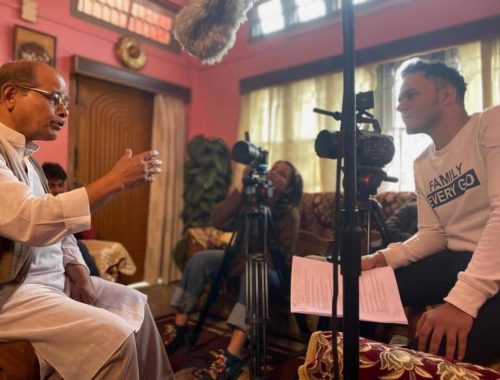by Srivatsan S:
For a serial killer premise, a filmmaker is posed by a challenge to sustain the level of intensity that (s)he builds with the opening shot, especially when it has some great aural and visual sense — like the case of Penguin, which opens with a rather disoriented set of dream-like images, of an angelic tombstone, a Charlie Chaplin figure with a yellow umbrella, a child in a yellow hood and a dog. We see the masked man (?) slicing the body of his prey, the child.
The nightmare unfolds on an early morning in what appears to be an abandoned forest where the man almost performs a ritualistic sacrifice, drowning himself to death with the minced body parts in the nearby river. But we are brought back to reality with a dog’s bark, when we find a pregnant Rhythm (Keerthy Suresh who sells the helplessness quite effectively) waking up next to her dog, Cyrus. Is this a pregnant woman’s worst nightmare or a premonition? The opening sequence, if anything, promises a delicious flavour of a South Korean horror and a taut investigative thriller.
Penguin’s story — the curious case of a missing boy — is told in flashback and is intercut with the present day Rhythm and her apparently lonely world. Early on, Rhythm narrates a tell-tale to her son Ajay, about a penguin mother’s grit and tenacity in retrieving her son from the sea. This seemingly cute bedtime story mirrors Rhythm’s real-life when a masked man abducts Ajay into the deep forests.
A mother’s pursuit in uncovering the mystery behind her son’s disappearance results in uncomfortable truths about herself
Days, months and years pass by but there is no trace of Ajay. He is, in fact, suspected to be dead by the investigating officers when they retrieve his clothes in the forest, a year later. But where Penguin becomes slightly interesting is when Ajay returns. After six years. Though the way by which he returns or the scene preceding his arrival seem concocted; you can see why they look and feel ‘constructed’. In Room (2015), when Jack finally sees the daylight after being in captivity for seven years, you cannot help but sympathise with his trauma. Likewise, in Penguin, Ajay takes a while to warm up to the new world. He disappeared as a child but returns as a boy. The questions loom large: where was he and with whom? Rhythm sets out to find the masked man before he preys on another child.
But the questions that trouble us are: what is the film’s motive and why does it keep changing every 20 minutes? It starts off like a regular investigative thriller with a serial killer backdrop and takes the form of a revenge for trivial reasons, in the end. The big climax reveal, which is hollow and does nothing to alter its course, seems like an afterthought written on paper with this description: ‘think of a twist…any twist.’ Kannamoochi, a web series by Avinaash Hariharan which dealt with a similar premise, was much clearer in terms of its structure.
Penguin is not a bad film but Eashvar’s idea of writing suspense gets clumsier as the story progresses. The filmmaker, however, is a revelation in terms of his visual sense. Two shots come to mind that are beautifully imagined and shot (cinematography is by Kharthik Phalani). The first is where Rhythm comes face-to-face with the Charlie Chaplin figure. Eashvar doesn’t show him, instead we see his rather mystical figure in the midst of fog. You can literally see his personality towering over Rhythm — almost to indicate his omnipresence in the forest. The second is when Rhythm finds Ajay on an empty road. She takes nervous looks at him before prostrating at his feet. The light from her car brings about the much-needed light into her otherwise dark world — it segues into an earlier scene where we see a poster of Michelangelo’s Pieta. It is a powerful image. It is sad that the movie does injustice to its own material.



